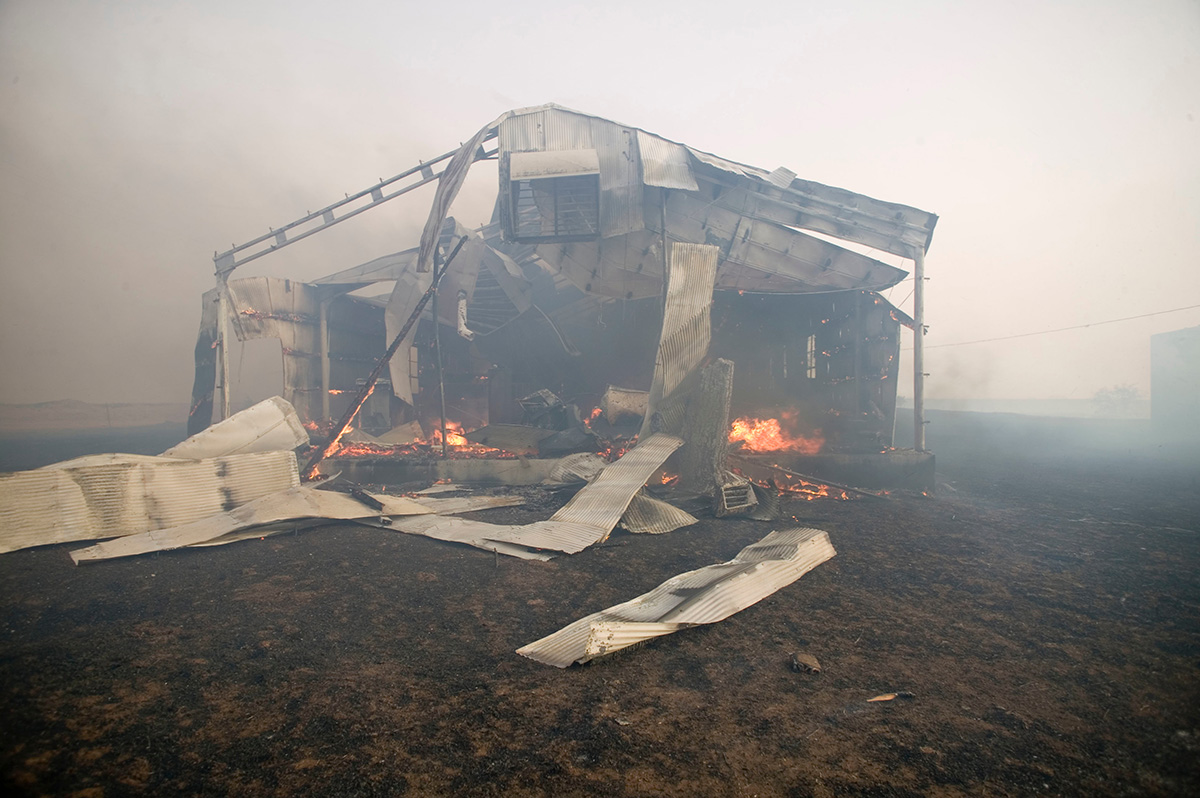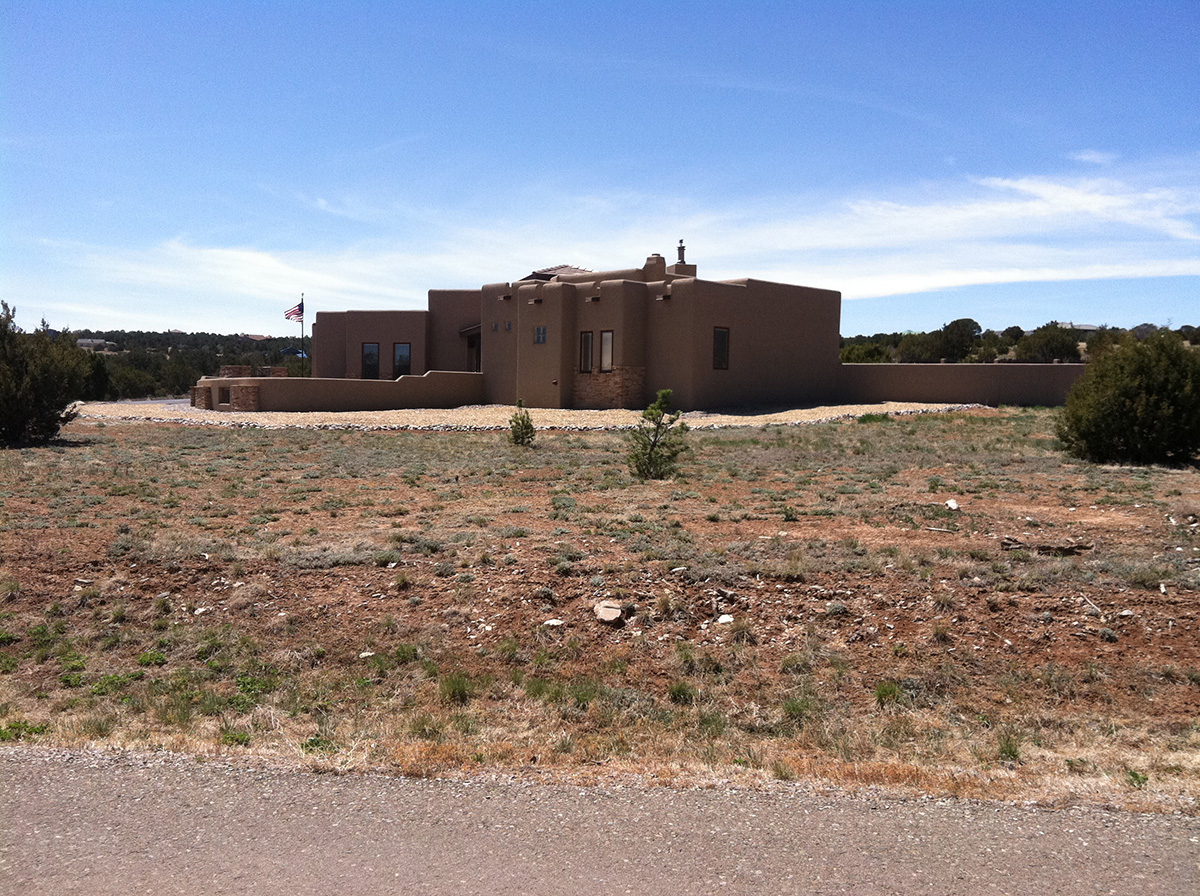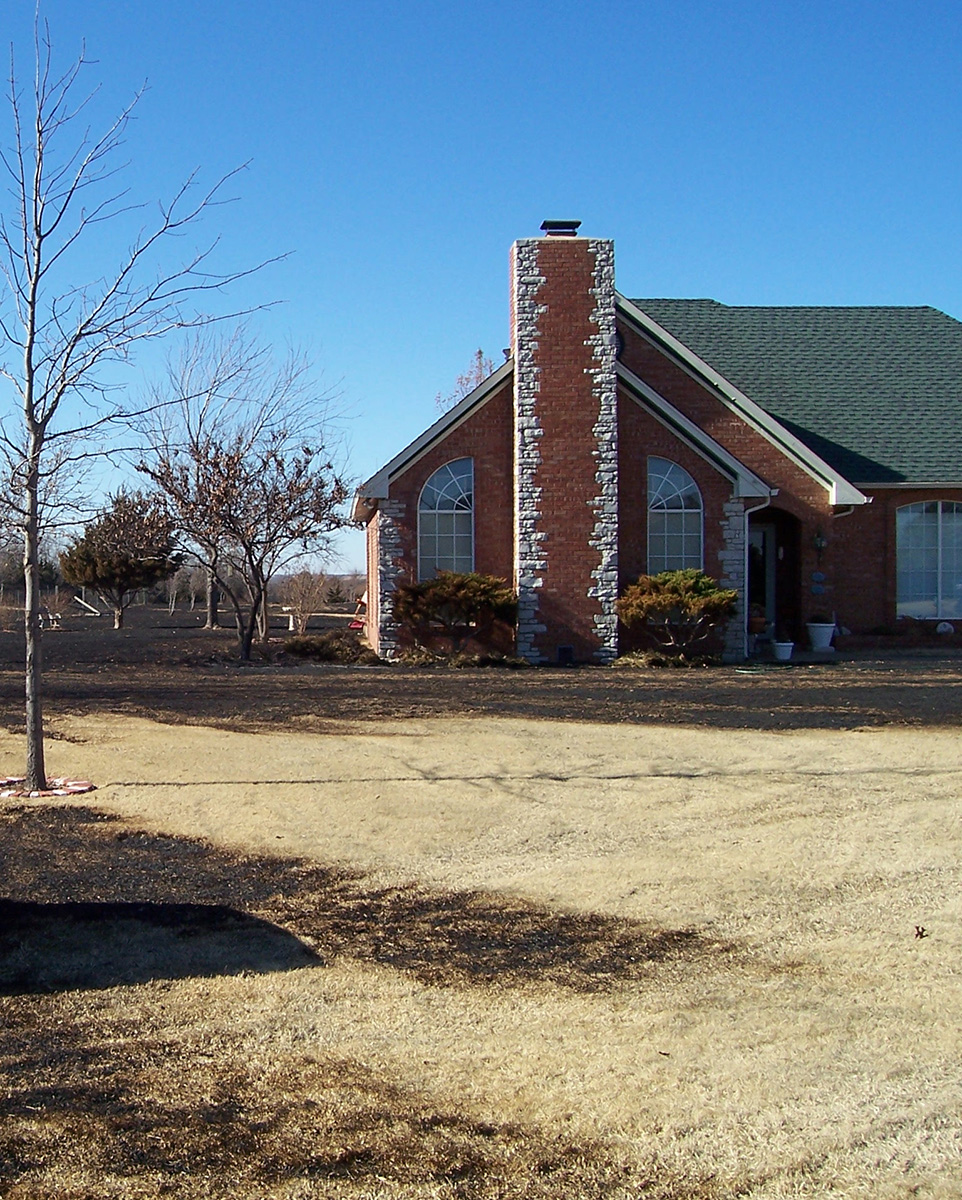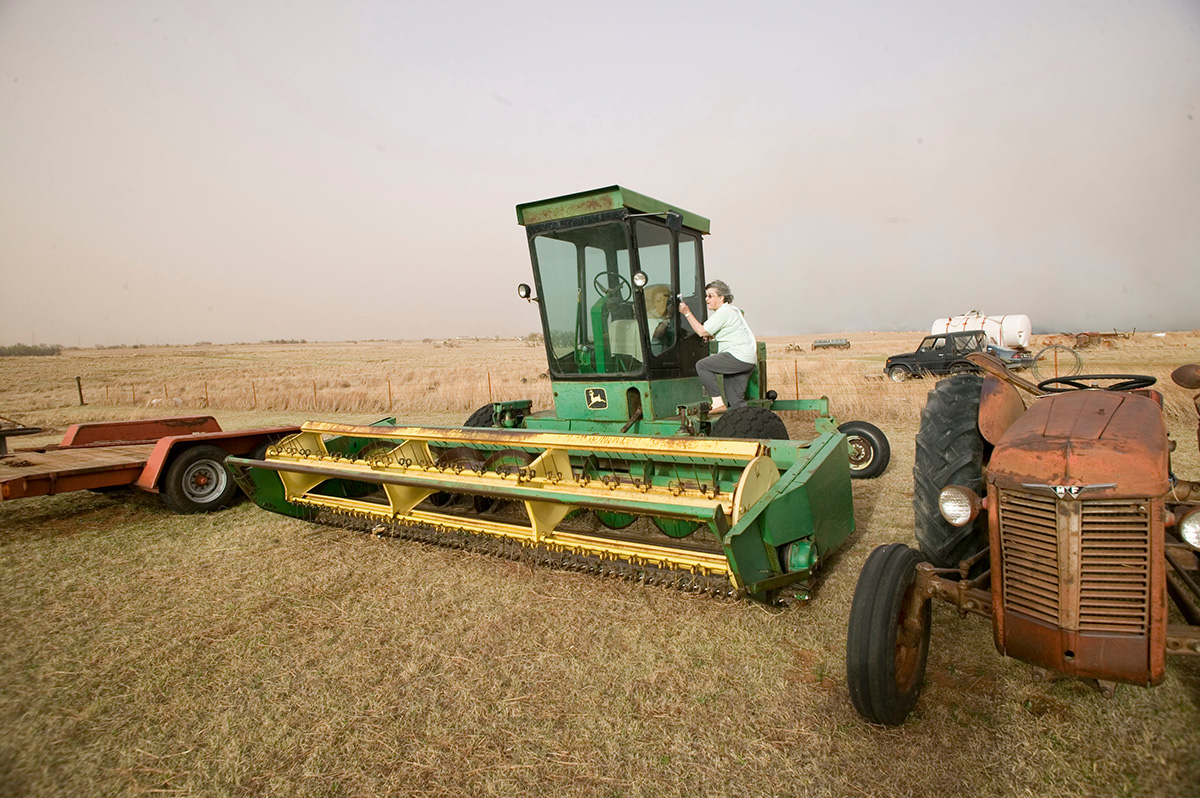Wildfire: Preparing the Ranch and Farm
Wildfire presents unique challenges to ranches and farms that typically do not apply to urban homeowners and neighborhoods. For example, farms and ranches often have multiple buildings, hay stacks, fuel storage tanks, livestock, limited water access, distant fire departments and are in close proximity to significant fuel loads. Sooner or later, most ranches and farms will be faced with an approaching wildfire. This publication provides suggestions on how to be prepared for wildfire if you live on a ranch, farm or rural setting.
The time to be thinking about protecting your home, barns, personal items and land is not as the fire is heading towards your property, but long before smoke is seen or smelled. Some properties have a higher risk for accidental fires, such as those located next to major highways, interstates or railroads. It is unreasonable to think there will be time to prepare property, livestock, equipment and family in the event of wildfire. Landowners should be aware that in the event a wildfire occurs under extreme weather conditions, there may not be enough time or resources available to protect homes and structures. This is especially true if mitigation steps, such as those described in this fact sheet, have not been implemented. It is up to the landowner to proactively make sure their home and buildings can survive a wildfire. With just a small amount of preparation work and annual maintenance, property can be made safer and better able to withstand wildfire.
Wildfires can occur at any time of the year; however, most occur during the dormant season or during periods of drought when fuels are dry. Fuel conditions, fuel loading, fuel arrangement, topography and weather conditions all affect the severity of wildfires. Of these factors, fuel loading and fuel arrangement around homes and structures can be changed or mitigated. There are no guarantees when facing a wildfire and not all of the methods listed in this document can or will completely protect your farm or ranch from every wildfire scenario. However, being prepared will increase the odds you and your family and property can survive a wildfire.

Wild Fire east of Stillwater consumed nearly 1000 acres and 8 structures. Fire fighters from many neighboring communities helped get the fire under control.
Be Prepared
Risk Management
Despite our best preparations, undesirable outcomes are still possible. One of the first steps is to call or schedule a meeting with your insurance agent for a policy review to ensure desired and adequate coverage is achieved. Simple questions need to be asked and answered. For example: Does my policy cover wildfire damage? To what extent? To what amount? Are hay storage, solar pumps, fences, equipment and outbuildings covered and to what amount? What about livestock killed by wildfire? What about emergency forage, especially if fences and forage are burned? Multiple policies with multiple companies may be required, depending on specific needs.
Keep important documents stored in fire- and waterproof boxes. Better yet, have original documents stored off-site in a safe deposit box. Include up-to-date written, photographic or video accounting of all personal and farm/ranch property. Do not forget items in barns, sheds, shops and outside. Back up photos and videos on secure cloud-based services, including scanned images of photographs.
In the event of an emergency evacuation, with only minutes to escape, grab essential medications and pets and go immediately. Adequate insurance and proper backup will provide security and peace of mind in the event the ranch or farm is threatened or damaged by wildfire.

Despite the best preparations, undesirable outcomes are still possible. One of the first steps is to call or schedule a meeting with your insurance agent for a policy review to ensure desired and adequate coverage. (Photo T. Johnson)
Homes, Barns and Buildings
Just a small amount of preparation work immediately around homes and structures, such
as trimming lawns, removing tall vegetation, pruning trees and shrubs and cleaning
roofs and gutters of flammable debris can buy extra time in a wildfire event.
Firewise.org calls the area of concern around homes and buildings the home ignition
zone (Figure 1). Even though these recommendations were developed for homes, the same
approach can be applied to barns, shops and other outbuildings. There are three main
zones of concern around homes and buildings: immediate, intermediate and extended.

The three zones of concern around homes and buildings: immediate, intermediate and extended. The immediate zone is the most important and work should begin there first. (From Firewise.org)
Immediate Zone
Within 5 feet of a Home, Barn or Building
- The most important zone
- Complete this zone first
- Remove leaves and debris from roof and gutters
- Do not store flammable items under deck or patio
- Move all flammable materials away from exterior walls, including mulch, flammable trees and shrubs, leaves, firewood piles, lumber piles and other combustible items
- Consider using non-combustible mulch, such as crushed stone or gravel around homes or buildings
- Choose landscape plants that are low-growing and free of resins, oils and waxes that burn easily. Space them carefully
- Use herbicide or gravel next to structures to keep an area free of vegetation right around buildings

Wild Fire east of Stillwater consumed nearly 1000 acres and 8 structures. Fire fighters from many neighboring communities helped get the fire under control.
Building Maintenance and Construction
- Replace or repair loose or missing shingles or other roofing material
- Make sure eaves and exterior attic vents have screens in place to keep out flying embers; 1/8-inch mesh wire screen is recommended
- Repair or replace damaged window screens and windows
- Screen or box in areas around patios and below decks to prevent embers or combustible materials from accumulating
- Repair or replace rotten or damaged wood siding
- Make sure wooden privacy fences are not attached directly to the house; metal gates can serve as a safety buffer
- Choose fire-resistant material for decks, patio furniture, swing sets and other items
- For barns and other buildings, make sure embers cannot enter through openings under the eaves. Place 1/8-inch metal screen material in these openings to keep embers out
- Select fire-resistant building materials for new construction, add-ons or remodels
Rooftops
Rooftops are of particular concern, mainly because they have the greatest potential for ignition from embers. Using nonflammable roofing materials can substantially reduce the risk of a structure catching on fire when embers fall on the rooftop. Class A roofing material (asphalt glass fiber composition shingles, metal, concrete tile, slate, clay tile) are effective against fire exposure and have been tested for fire resistance and dependability.

Consider using non-combustible mulch such as crushed stone or gravel around homes or buildings and move all flammable materials away from exterior walls, including mulch, flammable trees and shrubs, leaves, firewood piles, lumber piles, and other combustible items. This photo shows a good example of preparing the immediate (up to 5 feet) and intermediate (5 to 30 feet) zones around a home. (Photo D. Cram)
Intermediate Zone
5 to 30 feet from a Home, Barn or Building
Create firebreaks around homes and others structures with strategically placed driveways, sidewalks, walkways, patios and non-flammable decks
- Mow or graze lawns and native vegetation to heights of less than 4 inches
- Prune trees 6 to 10 feet up from the ground
- Remove vegetation and flammable mulch from under trees to reduce the risk of surface fires moving into tree crowns
- Plant or thin trees within 30 feet of a structure to have at least 18 feet between canopies, increasing the distance on steeper slopes
- Plant trees in locations where the mature canopy will not be within 10 feet of a structure
- Trees and shrubs within 30 feet of a structure should be limited to small groups or clusters to reduce fuel continuity
- Aboveground propane tanks should be placed the proper distance from the home or other buildings as recommended by National Fire Protection Association: 125 to 500 gallon tank: 10 feet; 501 to 2,000 gallon tank: 25 feet
- Aboveground fuel storage tanks should be placed well away from structures, preferably
on gravel or concrete pads
Clear and keep vegetation from growing under propane and fuel storage tanks


Preparation is key before a wildfire impacts your home, barns and land. A small amount
of preparation work, such as trimming lawns, pruning trees and cleaning up as illustrated
in the photo above will make your property safer in the event of a wildfire, giving
your home and other buildings a better chance of surviving (Photos J. Weir)
Extended Zone
30 to 200 feet from a Home, Barn or Building
- Use driveways and roads to create firebreaks
- Dispose of heavy accumulations of litter, debris and brush piles
- Remove dead trees
- Mow or graze to reduce fuel loads
- Do not allow small cedars/junipers to grow under or between mature trees
- Plant or thin trees within 30 to 60 feet from a structure to have at least 12 feet between canopies, increasing the distance on steeper slopes
- Plant or thin trees within 60 to 200 feet from a structure to have at least 6 feet between canopies. Increase the distance on steeper slopes
- Consider removing all highly flammable trees, such as cedars or junipers, within 200 feet of a structure.
- Place firebreaks inside fencelines along roads to help reduce wildfire risk on light wind days; however, do not expect this to effectively stop a fire on extremely windy days
- Conduct prescribed burns to create blackened areas around structures before wildfire season; make sure to burn before conditions become too dry or burn bans restrict the ability to burn
- Planned grazing can also be used to reduce or manage fuels and wildfire risk in this zone

Create a firebreak around the home ignition zone with a prescribed fire before wildfire season. Make sure the burn occurs before conditions become too dry or burn bans restrict the ability to burn. (Photo D. Scasta)
Hay Storage It is difficult to protect stored hay from blowing embers, but there are steps to take that can reduce direct flame ignition. Do not store all of your hay in one location, but place it in several locations to reduce the risk of it all burning at once. Some insurance companies will only insure a specific number of hay bales or a total value of hay in a stack, as well as having a required distance between insured hay stack locations. Check with your insurance agent for specific policy details.
- Store hay on bare ground if possible
- Mow or graze fuels down next to hay storage
- Create firebreaks around stored hay by blading or disking to bare ground
- Remove or reduce volatile fuels, such as cedars and junipers, around storage sites
- Store hay away from buildings, equipment or other items that may be damaged by burning hay bales
- If fires are likely to come from a specific direction, place hay on the opposite side of roads, ponds or other firebreaks to reduce the probability of fire reaching the bales

Don’t store all hay at one site, reduce fuel loads around hay storage and store away
from buildings, equipment or other items that radiant heat may damage.. (Photo T.
Johnson)

Store or park equipment at least 20 feet from other vehicles and buildings and on gravel or bare ground sites if possible. Reduce fuel or vegetation around and under equipment by mowing, disking, weed trimming or grazing. (Photo T. Johnson)
Outside Equipment Storage
- Park equipment at least 20 feet from other vehicles and buildings
- Park equipment on cement pads, bare ground or gravel. If this is not possible, regularly mow or graze vegetation in and around equipment
- Before parking, remove vegetation that has collected on or under equipment during operation
- Keep all wind-blown debris, such as tumbleweeds, from collecting around equipment
- Make sure equipment is not leaking fuel or other flammable fluids
- Wash equipment if fuel or fluids have leaked on equipment
- Keep all windows and doors on equipment closed to keep embers out
Livestock
Protecting livestock from wildfire can be dangerous. Entering into an unburned pasture with significant fuel loads and limited escape routes to open gates or cut fences is inherently risky. Be aware of the fire location, direction and rate of spread before making a decision to enter a pasture. If you are unsure of this critical information, do not enter.
- Do not try to herd animals in front of an oncoming wildfire; this is extremely dangerous
- Maintain gates so they open easily and without tools
- Prepare safe areas or firebreaks for livestock by maximizing trampling along fence lines and in pasture corners through strategic salt and mineral placement or winter feeding
- Manage fuel loads with timing, intensity, distribution and duration of grazing
- Consider using patch-burning techniques to create firebreaks and safety areas
- Conduct prescribed burns on a regular basis to reduce fuel loads and volatile fuels
- Create firebreaks and maintain roads along pasture perimeters to reduce fuels, as well as making safe areas for livestock to congregate
- Have a livestock evacuation plan that considers how and where livestock will be taken in the event of a wildfire
- Carry fence pliers to cut a rapid escape route if you find yourself trapped by fire
What to do if a Wildfire is Approaching
(from Firewise USA, NFPA, FEMA)
- Know where to find the latest news and updates from the local media and fire department and check frequently during a wildfire event. The situation can change rapidly
- Make sure to have important phone numbers readily available: fire department, county sheriff and neighbors
- Recommended emergency evacuation prioritization list: People first, prescriptions, important documents, personal needs, keepsakes and valuables
- Place an emergency supply kit and other valuables in your vehicle
- Call for assistance if needed, but remember emergency response resources may be limited or tied up at other sites

Create safe areas for livestock with salt and mineral placement or winter feed grounds along fence lines or in pasture corners. Remember, do not try to herd animals in front of wildfire, it isn’t worth your life. (Photo T. Johnson)
Preparing to Evacuate
- Close all entrances, windows and openings to home and buildings. This includes doors, garage doors, windows, vents and any other entrances. This action is recommended to prevent embers from blowing in and igniting inside structure
- Close shutters, heavy drapes, blinds or other window coverings to reduce radiant heat exposure to items near windows
- Turn on outside and inside lights to make house more visible in dense smoke
- Move patio or deck furniture, cushions, doormats and potted plants in wooden containers either indoors or as far away from the home, shop or barn as possible.
- Turn off natural gas at meter or propane/butane at the tank.
- Back vehicles into garage or outside buildings, then close the doors. If you cannot park the vehicles inside, park them heading in the direction of the nearest evacuation route. If you do have to leave, make sure to close doors behind you.

Have a livestock evacuation plan that considers how and where livestock will be taken in the event of a wildfire. (Photo T. Johnson)
If Evacuation Becomes Necessary
- Leave as early as possible. Promptly leaving clears roads for firefighters to get equipment in place to fight the fire
- Always let someone know you have left home and your location
- Make sure vehicle lights are on
- Drive slowly; watch for other vehicles, people on foot or loose livestock
- If possible, avoid driving through dense smoke
- Take your family to a safe location; be aware that a wind shift can make a previously safe location unsafe

Know where to find the latest news and updates from the local media and fire department
and check frequently during a wildfire event. The situation can change rapidly. Make
sure to have important phone numbers readily available: fire department, county sheriff
and neighbors. (Photo T. Johnson)
What to do if Trapped in a Vehicle
In the event you become trapped in a vehicle (car, truck, cab tractor other equipment with a cab) with fire coming at you, or your vehicle becomes stranded in front of a fire, do not try to get out and outrun the fire. Roll up the windows and turn on the air conditioner to recirculate air inside the car. This will help minimize smoke from getting inside the vehicle. Try to park the car in an area away from heavy fuels, such as brush and trees. If possible, put an obstacle between you and the flames (e.g., another vehicle, building, concrete wall) to shield you from radiant heat. Leave the engine running and get down as low as possible from the windows to shield yourself from radiant heat. Cover your face and exposed skin with dry fabric. Try and remain calm and do not exit until the flames have passed. You will be able to breathe, although it will get hot and smoky for a moment. The tires on the vehicle may burst due to heat and possibly catch on fire, as will some of the wiring and other plastic items. The vehicle will not explode. Stay in your vehicle until the fire passes. If the vehicle is drivable, move along; if not, get out and assess the situation.

If you have to evacuate, leave as early as possible. Promptly leaving clears roads for firefighters to get equipment in place to fight the fire. Turn on your headlights when evacuating and driving in smoke. (Photo T. Johnson)
Staying
The decision to stay in the face of danger such as wildfire, hurricane or tornado is a personal decision, but it is not advisable. Worst-case wildfire scenarios include high winds with blowing embers and debris. An added complication is that fire may arrive in the middle of the night, making visibility even more difficult. Evacuation is the prudent choice. The choice to stay in a structure should only be made if adequate preparations have been made well ahead of time (i.e., not in the hours before a fire arrives). For example, all the recommendations in the three home-ignition zones should have already been implemented. FireWise recommendations for construction and maintenance should have been followed to reduce the risk of ember ignition. Understand that it may be impossible to mitigate for heavy smoke and that smoke inhalation may lead to injury or death.
- Have a shovel and rake, along with several long water hoses set up and accessible
- Fill buckets and bulk containers with water
- Have items set up in an accessible spot outside the home
- Make sure to protect yourself—wear cotton/wool clothing, including long pants, long-sleeved shirt, safety glasses, cap and leather gloves. Avoid synthetic material
- Wildfires often take out power lines and rural water, which can reduce or eliminate pressurized water supplies. Do not base a fire-fighting strategy on having this water supply available
What to do if Trapped in a House or Building
- It is safer to stay inside a house than go outside in a burnover situation
- A house will provide protection from heat and flames
- Shut all doors, windows and vents
- Close shutters, heavy drapes, blinds or other window coverings to reduce radiant heat
- Move to the center of the house until the flaming front passes, then move towards the side from which the fire approached, where the air may be less smoky and escape more feasible
- Assess the situation during and after flaming front
Other Resources
Firewise USA www.Firewise.org
National Fire Protection Association www.nfpa.org
Ready.gov https://www.ready.gov/wildfires
Fire Adapted Communities https://fireadapted.org
How to prepare for a wildfire www.fema.gov
Management After Wildfire, Fact-Sheet: NREM-2881
Special thanks to the USDA Southern Plains Climate Hub, Great Plains Fire Science Exchange and Oklahoma Association of Conservation Districts for providing support for the publication of this document.
John R Weir
Research Associate, Natural Resource Ecology and Management
Oklahoma State University
Morgan L. Russell
Extension Range Specialist, Ecosystem Science and Management
Texas A&M Agrilife Extension Service
Doug Cram
Extension Fire Specialist, Extension Animal Sciences and Natural Resources
New Mexico State University
Carol E. Baldwin
Research Assistant Professor, Horticulture and Natural Resources
Kansas State University
Pete Bauman
Extension Range Field Specialist, Natural Resource Management
South Dakota State University
J. Derek Scasta
Rangeland Extension Specialist, Ecosystem Science and Management
University of Wyoming
